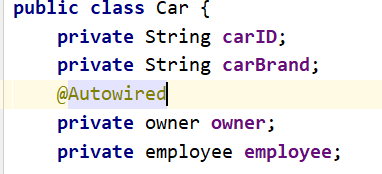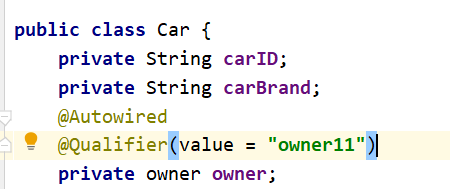您好,登錄后才能下訂單哦!
您好,登錄后才能下訂單哦!
在IOC容器中學習相關注解(常用)
1. @Autowireda.作用對象:(官網解釋)
1. You can apply the @Autowired annotation to constructors:
2.you can also apply the @Autowired annotation to "traditional" setter methods:
3.You can also apply the annotation to methods with arbitrary names and/or multiple arguments:
4.You can apply @Autowired to fields as well and even mix it with constructors:
5.It is also possible to provide all beans of a particular type from the ApplicationContext by adding the annotation to a field or method that expects an array of that type:
6.Even typed Maps can be autowired as long as the expected key type is String. The Map values will contain all beans of the expected type, and the keys will contain the corresponding bean names:等
總結一下就是: 可以在構造器,set方法,任意方法和屬性上,數組上,String類型的Map上等。
Notes:1.@Autowired默認按類型裝配(這個注解是屬業spring的),默認情況下必須要求依賴對象必須存在,如果要允許null值,可以設置它的required屬性為false。
2.可以與@qualifier 共同使用, 當對象類型和名字發生沖突時,該注解可用于指定特定的對象。
@Autowired()
@Qualifier("cat")
可以找到id="cat"的beanb.功能:它可以對類成員變量、方法及構造函數進行標注,完成自動裝配的工作。通過 @Autowired的使用來消除 set ,get方法。2.@Resourcea.功能: @Resource的作用相當于@Autowired,只不過@Autowired按byType自動注入,而@Resource默認按 byName自動注入
@Resource有兩個屬性是比較重要的,分是name和type,Spring將@Resource注解的name屬性解析為bean的名字,而type屬性則解析為bean的類型。所以如果使用name屬性,則使用byName的自動注入策略,而使用type屬性時則使用byType自動注入策略。如果既不指定name也不指定type屬性,這時將通過反射機制使用byName自動注入策略。
3.@Requireda.功能:@Required 注釋應用于 bean 屬性的 setter 方法,它表明受影響的 bean 屬性在配置時必須放在 XML 配置文件中,否則容器就會拋出一個 BeanInitializationException 異常。下面顯示的是一個使用 @Required 注釋的示例。
這有一個很好的解釋和例子關于@Required注解
使用@Autowired后的優點
原來我們需要手動注入之后才可以使用employee對象:
<bean> <property name="employee" ref="employee"/>
若沒有進行手動注入,不會從測試代碼中 獲取到employee對象。
使用@Autowired之后
不需要手動注入。
<bean id="car" class="com.ding.pojo.Car"/>
只用在屬性上進行@Autowired注釋標注

在測試類中即可直接調用:
public class MyTest {
public static void main(String[] args) {
ApplicationContext context = new ClassPathXmlApplicationContext("applicationContext.xml");
Car car = (Car) context.getBean("car");
car.getOwner().MyEmployment();
}
}
系統首先根據 bean中class類型進行確認,再和bean中id名進行確認,最后確定所定的注入對象。 若多個bean 名字不同,且類型相同則該注釋失效。(可使用@Qualifier 進行唯一指定)
例如:
<bean id="owner22" class="com.ding.pojo.owner"/>
<bean id="owner11" class="com.ding.pojo.owner"/>
運行相同代碼會報如下錯誤:

此時加上@Qualifier注釋如下,代碼可正常編譯:

運行結果:

如分享內容中有問題的地方,還望您多加指出,感謝您的瀏覽。
以上就是本文的全部內容,希望對大家的學習有所幫助,也希望大家多多支持億速云。
免責聲明:本站發布的內容(圖片、視頻和文字)以原創、轉載和分享為主,文章觀點不代表本網站立場,如果涉及侵權請聯系站長郵箱:is@yisu.com進行舉報,并提供相關證據,一經查實,將立刻刪除涉嫌侵權內容。